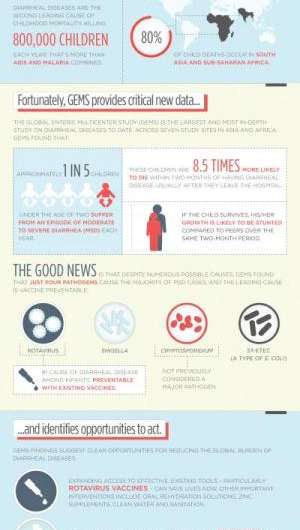A handful of pathogens are causing most diarrhoeal deaths and illness in children worldwide and should be targeted
New research in The Lancet reports that just four pathogens—rotavirus, Cryptosporidium, enterotoxigenic Escherichia coli producing heat-stable toxin, and Shigella—are causing most cases of moderate-to-severe diarrhoea among children living in the poorest countries of the world.
"Targeting these pathogens with existing interventions, such as the rotavirus vaccine, as well as developing new therapies and treating the malnutrition that follows MSD, could have a large impact on the mortality and morbidity caused by this debilitating condition," say the authors, led by Drs Myron Levine and Karen Kotloff, Center for Vaccine Development, University of Maryland School of Medicine, MD, USA. The study was funded by the Bill & Melinda Gates Foundation.
A recent Lancet article estimated that globally, 800,000 children were killed by diarrhoeal illness in 2010. Thus interventions that make a significant impact on reducing this toll will lead to substantial reductions in child mortality and morbidity. However, current data derived from direct measurements of the burden and aetiology of MSD from sub-Saharan Africa and South Asia, where most deaths occur, are needed to inform global estimates that often serve as the basis for setting priorities for diarrhoea prevention and treatment efforts.
The new research assessed data from the Global Enteric Multicenter Study (GEMS)—a 3-year study of MSD among children younger than 5 years old, residing in censused populations at four African and three Asian sites in Kenya, Mali, Mozambique, The Gambia, Bangladesh, India, and Pakistan. MSD cases seeking care at health centres (n=9439) were recruited along with 1 randomly-selected, matched, community-control children without diarrhoea (n=13 129). From these cases and controls, the researchers collected clinical and epidemiological data, anthropometric measurements, and a faecal sample to identify pathogens at enrolment. A single follow-up home visit was made approximately 60 days later to ascertain vital status, clinical outcome, and interval growth.

The researchers found that most attributable cases of MSD across all sites were due to four pathogens: rotavirus, Cryptosporidium, enterotoxigenic Escherichia coli (ETEC) producing heat-stable toxin (ST), and Shigella. Other pathogens were important at selected sites: Aeromonas in Pakistan and Bangladesh; Vibrio cholerae O1 in all three Asian sites plus Mozambique, and Campylobacter jejuni in the three Asian sites.
Other findings of note were that MSD cases had significantly more linear growth faltering than controls during the follow-up period, and the odds of dying during follow-up were 8•5-fold higher among MSD cases than controls. Most deaths (88%) occurred during the first 2 years of life. When MSD cases who died were compared with MSD cases who survived, those who died were significantly more like to be infected with ST-producing ETEC with a risk of death twice as high; typical enteropathogenic E coli among infants aged 0 months (2•6 times increased risk); and Cryptosporidium among toddlers aged 12 months (2.3 times increased risk).
"Evidence from GEMS that rotavirus is the most common cause of MSD at every site during the first year of life renders optimism that the decision by the GAVI Alliance to make rotavirus vaccines available to the world's poorest countries will substantially benefit global child health," says Dr Levine, the senior author. The authors also describe as "remarkable" that Cryptosporidium was an important pathogen at all sites regardless of HIV prevalence, and the second most common pathogen in infants. The authors say: "These observations highlight the need to develop tools to diagnose, treat, and prevent cryptosporidiosis in resource-poor settings."
They conclude: "Our results documenting the considerable burden of MSD in sub-Saharan Africa and South Asia and its close relationship to malnutrition indicate that preventive strategies targeting as few as four pathogens could potentially reduce this disease and its sequelae by about 40% during the first 2 years of life. Accordingly, there is urgent need to accelerate introduction of existing interventions with proven effectiveness, such as rotavirus vaccination and adjunct treatment of acute diarrhoea with zinc, to develop additional strategies with potential high impact, such as new vaccines, and to revitalise diarrhoeal disease case management algorithms shown to reduce malnutrition."
In a linked Comment, Dr Uma chandra mouli Natchu and Dr Shinjini Bhatnagar, Paediatric Biology Centre, Translational Health Science and Technology Institute, Gurgaon, Haryana, India, say: "The GEMS investigators should be commended for a study that has generated and analysed microbial data from such a large number of children with standardised methods across seven sites spanning two continents... Large-scale periodic microbial surveillance for high-burden infectious diseases, such as GEMS for diarrhoea, will be crucial in the development and choice of appropriate region-specific interventions for the control of these infections."
More information: www.thelancet.com/journals/lan … (13)60844-2/abstract













